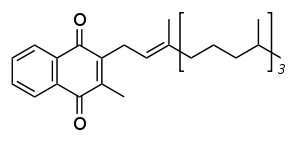Menadione
Menadione is an organic compound with the formula C6H4(CO)2C2H(CH3). It is an analog of 1,4-naphthoquinone with a methyl group in the 2-position.[2] It is occasionally used as a nutritional supplement in animal feed because of its vitamin K activity.
 | |
 | |
| Names | |
|---|---|
| IUPAC name
2-Methylnaphthalene-1,4-dione | |
| Other names
Menaphthone; Vitamin K3; β-Methyl-1,4-naphthoquinone; 2-Methyl-1,4-naphthodione; 2-Methyl-1,4-naphthoquinone | |
| Identifiers | |
3D model (JSmol) |
|
| ChEBI | |
| ChEMBL | |
| ChemSpider | |
| DrugBank | |
| ECHA InfoCard | 100.000.338 |
| KEGG | |
PubChem CID |
|
| UNII | |
CompTox Dashboard (EPA) |
|
| |
| |
| Properties | |
| C11H8O2 | |
| Molar mass | 172.183 g·mol−1 |
| Appearance | Bright yellow crystals |
| Density | 1.225g/cm3 |
| Melting point | 105 to 107 °C (221 to 225 °F; 378 to 380 K) |
| Insoluble | |
| Pharmacology | |
| B02BA02 (WHO) | |
| Hazards | |
| Flash point | 113.8 °C (236.8 °F; 386.9 K) |
| Lethal dose or concentration (LD, LC): | |
LD50 (median dose) |
0.5 g/kg (oral, mouse) |
Except where otherwise noted, data are given for materials in their standard state (at 25 °C [77 °F], 100 kPa). | |
| Infobox references | |
Terminology
It is sometimes called vitamin K3,[3] although derivatives of naphthoquinone are not naturally occurring chemicals and therefore do not qualify as vitamins, and without the side chain in the 2-position (which, as the methyl group is retained in vitamin K, in the structural formula of menadione is the unsubstituted 3-position) they cannot exert all the functions of the K vitamins. Menadione is metabolized by the human body into K2 which uses alkylation to yield menaquinones (MK-n, n=1–13; K2 vitamers), hence is better classified as a provitamin.
It is also known as menaphthone.[4]
Uses
It is an intermediate in the chemical synthesis of vitamin K by first reduction to the diol menadiol, which is susceptible to coupling to the phytol.[5]
Despite the fact that it can serve as a precursor to various types of vitamin K, menadione is generally not used as a nutritional supplement in economically developed countries. Menadione for human use at pharmaceutical strength is available in some countries with large lower income populations. It is used in the treatment of hypoprothrombinemia outside of the United States.

Toxicity
Large doses of menadione have been reported to cause adverse outcomes including hemolytic anemia due to glucose-6-phosphate dehydrogenase deficiency, neonatal brain or liver damage, or neonatal death in some rare cases. In the United States, menadione supplements are banned by the U.S. Food and Drug Administration because of their potential toxicity in human use.
Low-dose menadione is still used as an inexpensive micronutrient for livestock in many countries. Forms of menadione are also included in some pet foods in developed countries as a source of vitamin K. These doses have yielded no reported cases of toxicity from menadione in livestock or pets. Although handling may be hazardous, the European Food Safety Authority found in 2013 that it is an effective source of vitamin K in animal nutrition that does not pose a risk to the environment.[6]
Research
Menadione in combination with vitamin C has been investigated for the treatment for prostate cancer.[7][8]
References
- The Merck Index, 11th Edition, 5714
- Castro FA, Mariani D, Panek AD, Eleutherio EC, Pereira MD (2008). Fox (ed.). "Cytotoxicity mechanism of two naphthoquinones (menadione and plumbagin) in Saccharomyces cerevisiae". PLOS ONE. 3 (12): e3999. Bibcode:2008PLoSO...3.3999C. doi:10.1371/journal.pone.0003999. PMC 2600608. PMID 19098979.
- Scott GK, Atsriku C, Kaminker P, Held J, Gibson B, Baldwin MA, Benz CC (September 2005). "Vitamin K3 (menadione)-induced oncosis associated with keratin 8 phosphorylation and histone H3 arylation". Molecular Pharmacology. 68 (3): 606–15. doi:10.1124/mol.105.013474. PMID 15939799.
- "Vitamin K". Retrieved 2009-03-18.
- Weber F, Rüttimann A (2012). "Vitamin K". Ullmann's Encyclopedia Of Industrial Chemistry. Weinheim: Wiley-VCH. doi:10.1002/14356007.o27_o08.
- EFSA Panel on Additives and Products or Substances used in Animal Feed (FEEDAP) (January 2014). "Scientific Opinion on the safety and efficacy of vitamin K3 (menadione sodium bisulphite and menadione nicotinamide bisulphite) as a feed additive for all animal species". EFSA Journal. 12 (1): 3532. doi:10.2903/j.efsa.2014.3532.
- Jamison JM, Gilloteaux J, Taper HS, Summers JL (January 2001). "Evaluation of the in vitro and in vivo antitumor activities of vitamin C and K-3 combinations against human prostate cancer". The Journal of Nutrition. 131 (1): 158S–160S. doi:10.1093/jn/131.1.158S. PMID 11208954.
- Tareen B, Summers JL, Jamison JM, Neal DR, McGuire K, Gerson L, Diokno A (March 2008). "A 12 week, open label, phase I/IIa study using apatone for the treatment of prostate cancer patients who have failed standard therapy". International Journal of Medical Sciences. 5 (2): 62–7. doi:10.7150/ijms.5.62. PMC 2288789. PMID 18392145.
External links
- Menadione in the Pesticide Properties DataBase (PPDB)